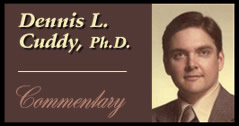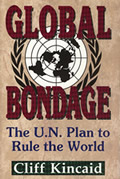A FALLING AWAY
PART 1
By
Dennis L. Cuddy, Ph.D.
August 10, 2009
NewsWithViews.com
[Note: A brief CIA-Iran timeline: in 1953 the CIA helps overthrow the democratically elected leader Mossadegh and reinstates Pahlavi (the Shah) with the approval of Ayatollah Kashani. In the late 1970s, the Shah became convinced the CIA was behind calls for his removal from power. On January 16, 1979, the Shah and his wife left Iran, staying in several countries before David Rockefeller requested President Carter allow the Shah to enter a New York hospital for surgery on October 22, 1979 (the Shah left the U.S. on December 15, 1979).
The U.S. Embassy in Iran had been taken over briefly by Marxists on February 14, 1979 not long after the Shah left. U.S. Ambassador William Sullivan and 101 others were taken hostage but freed by forces loyal to Ayatollah Khomeini after a 3-1/2 hour gun battle. After the takeover ended, Ambassador Sullivan returned to the U.S. and later told Dr. Stan Monteith that he warned President Carter and National Security Advisor Zbigniew Brzezinski (ZB) that if they allowed the Shah to enter the U.S., our embassy in Iran would be taken over again. Why, then, did Carter and ZB admit the Shah, especially without additional military protection of the Embassy? ZB had a pan-Islamic crescent strategy to buffer Soviet expansion and he already lured them into Afghanistan to bog them down as the U.S. had been in Viet Nam. The Soviets had perhaps 24 divisions ready to move into Iran, and the U.S. needed an “incident” to show how rapidly we could deploy responding forces if necessary. The second Embassy takeover on November 4, 1979 with 60 American hostages (plus others) afforded an alleged rescue attempt which seemed designed to fail (e.g., how did they expect a large enough force to succeed to get into and out of the Embassy without incident?).
A “confidential” Foreign Report (April 30, 1980) gave details of what really happened April 24, 1980 just before the U.S. raid. A small part of this report revealed: “The Israelis were helping the Americans to jam the systems of two Soviet spyships that regularly cruise around Lebanon, Israel and Egypt.” The Egyptians jammed “Russian surveillance instruments operating out of Libya.” When the Soviets did spot American aircraft heading toward Iran, they informed the Iranians, who “did not send a single fighter aircraft up to intercept the American intruders.” Why not? Why would they if the whole affair was staged by the CIA and its Iranian agents?
The Shah was replaced by Ayatollah Khomeini (mentored by Ayatollah Kashani) on December 3, 1979 as the First Supreme Leader of the Islamic Republic of Iran. And Iranian terrorist activity against the U.S. was planned shortly thereafter.
CIA Middle East operative Robert Baer in See No Evil said he looked at “an intelligence report from March 1982—a full thirteen months before the U.S. Embassy bombing in Beirut, Lebanan—stating that Iran was in touch with a network capable of destroying the Embassy. A subsequent report even specified a date the operation should be carried out.” Ask yourself why the U.S. government didn’t stop this bombing it knew would occur!
Six months after the Embassy bombing on April 18, 1983, the U.S. Marine Barracks in Beirut was bombed on October 23, 1983 killing 220 Marines and 79 other U.S. servicemen. In 1988, the U.S. Navy’s Fleet Center in Naples, Italy also was bombed. Those responsible for the bombings reported to Iranian Prime Minister Mir-Hossein Mousavi.
In May 2007, President Bush issued an order for the CIA to destabilize the government of Iranian President Mahmud Ahmadinejad, and in the Iranian election of 2009, who was portrayed positively by the U.S. as Ahmadinejad’s opponent? It was Mousavi, known as the “Butcher of Beirut”! Ask yourself why our government would do this.]
The Biblical reference to only a “few” being chosen or saved can be found in Matthew 7:14, 20:16, 22:14, and Luke 13:23. Most Christians don’t like to dwell on this, or they think they are one of the “few.” How can so many be deluded? It happens when they don’t recognize that they are in the time of “a [moral] falling away” (2 Thess. 2:3). They rationalize they are “basically good” people and that’s enough, not realizing that no matter how many good deeds one might do, if he or she supports the violent shedding of innocent blood by abortion, for example, then acceptance of Christ as Lord and Savior cannot be “complete” (something required for salvation).
The time of widespread “falling away” perhaps began in the 1960s when Bible-reading and school prayer ended in public schools, and was replaced by the religion of Secular Humanism and situation ethics. These gave rise to slogans such as “Don’t impose your morality on me,” which was followed by the unwillingness of a majority of people to overturn the Supreme Court’s 1973 decisions of Roe v. Wade and Doe v. Bolton, allowing abortion almost on demand.
Secondly, Jesus is described in The Holy Bible as “the Truth,” and the “falling away” from this under Secular Humanism can be seen, for example, when a federal court in the 1980s ruled that public school students could be forced to read a series of (35) stories that had children lying or rebelling against their parents with no negative consequences. Confirming the acceptability of lying was Dr. Michael Lewis of the New Jersey Robert Wood Johnson Medical School on NBC’s “Today Show” (January 22, 1990) when he said: “Lying is an important part of social life, and children who are unable to do it are children who may have developmental problems.”
That lying was becoming generally more acceptable by this time can be seen by a December 5, 1989 USA Today poll indicating that only 56% said they teach honesty to their children. Since cheating is also being dishonest, relevant to this is the fact that a poll of students conducted for the Girl Scouts by a division of Louis Harris and Associates conducted September 14-October 30, 1989 found that 65% of high school students would cheat on an important exam. And isn’t it generally recognized that many people “fudge” (cheat) on their taxes?
Thirdly, even though The Holy Bible clearly indicates that fornicators “shall not inherit the kingdom of God” (1 Corinthians 6:9 and Galatians 5:19-21), a “falling away” from maintaining sexual abstinence outside of marriage has been quite evident. In the 1960s and 1970s, popular movies increasingly included fornication. And studies by the Centers for Disease Control showed, for example, that from 1982 to 1988 the percentage of 15-year-old girls having sex increased from 18% to 29%. Admired athletes began publicly to boast of their many sexual “conquests.” And a TV documentary “Against Her Will” about twenty years ago revealed that 35% of college males surveyed reported that they would commit rape if they knew they would not get caught.
Even a number of prominent members of the clergy have been exposed for their sexual immorality, and some of them as well as other TV evangelists have been millionaires, despite the admonition of Matthew 19:24 that “it is easier for a camel to go through the eye of a needle, than for a rich man to enter into the kingdom of God.” Perhaps they should have listened to the popular song, “Would Jesus Wear A Rolex?”
Society was conditioned to accept sexual immorality. Characters such as Luke on “General Hospital,” Ross on “All My Children,” and John on “As The World Turns,” raped women and became heroes later on these TV soap operas.
About twenty years ago, cursing was also promoted, as in the first half hour of TV’s prime time “Jake and the Fat Man” (December 27, 1989), the stars cursed nine times. In twenty minutes of “Mancuso, FBI” (December 29, 1989), they cursed six times. And within one 15-minute period and another 10-minute period of “Kojak” (January 6, 1990), they cursed five times in each period.
|
Subscribe to the NewsWithViews Daily News Alerts! |
Even authority figures such as the police were portrayed as having no problem with breaking the law. In one of the first episodes of the TV series “Hardball” in 1990, the two leading characters (police officers) don’t flip a coin to see who rides the bike, but rather they toss rocks at a streetlight, causing one of them to say, “Now we’re lawbreakers.” Earlier (Ladies Home Journal, July 1980), Dan Rather of CBS revealed that “as a reporter… I’ve tried everything…. I had someone at the Houston police station shoot me with heroin so I could do a story about it.”
� 2009 Dennis Cuddy - All Rights Reserved

















